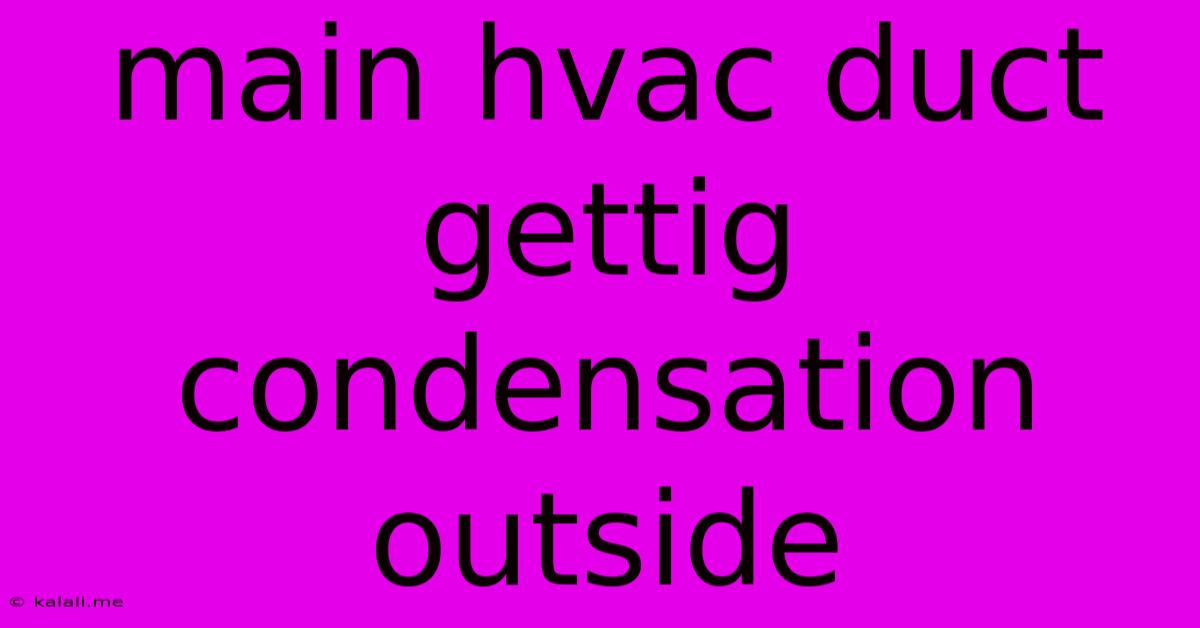Main Hvac Duct Gettig Condensation Outside
Kalali
Jun 05, 2025 · 3 min read

Table of Contents
Main HVAC Duct Getting Condensation Outside: Causes and Solutions
Meta Description: Dealing with condensation on your main HVAC duct outside? This comprehensive guide explores the common causes, from insufficient insulation to high humidity, and offers practical solutions to prevent water damage and improve efficiency.
Condensation on your main HVAC duct outside is a common problem that can lead to water damage, mold growth, and reduced HVAC system efficiency. Understanding the root causes is crucial for implementing effective solutions. This article will delve into the reasons behind this issue and provide you with practical steps to address it.
Understanding HVAC Duct Condensation
Before diving into solutions, let's understand why condensation occurs. The process is simple: warm, moist air comes into contact with a cold surface (your HVAC duct), causing the moisture in the air to condense into liquid water. This is especially prevalent in humid climates or during periods of high humidity. The outside duct, often exposed to cooler temperatures, acts as the perfect condensation point.
Common Causes of External HVAC Duct Condensation
Several factors contribute to condensation on your exterior HVAC ductwork. These include:
- Insufficient Insulation: Poor or inadequate insulation on the ductwork allows the outside air to cool the duct significantly, increasing the likelihood of condensation. This is a primary culprit in many cases.
- High Humidity: Areas with high humidity levels naturally have more moisture in the air, making condensation more prone to occur. This is especially true during warmer months.
- Air Leaks: Leaks in the ductwork can allow warm, moist air to escape, further contributing to condensation on the cooler exterior sections. This can also impact the efficiency of your HVAC system.
- Temperature Differences: A significant temperature difference between the air inside the duct and the surrounding air outside greatly increases the risk of condensation. This is exacerbated by poorly insulated ducts.
- Improper Ductwork Installation: Incorrectly installed ductwork, such as improperly sealed joints or insufficient slope for drainage, can exacerbate condensation problems.
Effective Solutions to Prevent External HVAC Duct Condensation
Addressing condensation requires a multi-pronged approach. Here are some effective solutions:
- Adding Insulation: This is often the most effective solution. Consider adding insulation to your existing ductwork using appropriate materials like fiberglass or foam insulation. Ensure a proper seal to prevent moisture intrusion.
- Improving Ventilation: Proper ventilation in your home can reduce humidity levels, minimizing the amount of moisture available for condensation. Consider installing exhaust fans in bathrooms and kitchens.
- Sealing Air Leaks: Identify and seal any leaks in your ductwork using specialized duct sealant. This improves the overall efficiency of your HVAC system and reduces condensation by preventing warm, moist air from escaping.
- Installing a Vapor Barrier: A vapor barrier can prevent moisture from penetrating the insulation and further reducing condensation. This is particularly useful in humid climates.
- Consider a Duct Wrap: Applying a specialized duct wrap to the exterior of your ductwork can provide an additional layer of insulation and protection against moisture.
- Regular HVAC Maintenance: Regular maintenance checks can identify potential problems early on, before they escalate into major issues like condensation.
Preventing Future Problems
Once you've addressed the existing condensation, take preventative steps to avoid future issues:
- Regularly Inspect Your Ductwork: Conduct periodic inspections to check for any signs of damage, leaks, or insulation deterioration.
- Maintain Proper Humidity Levels: Use a dehumidifier, especially during humid seasons, to help regulate humidity levels in your home.
- Ensure Proper Drainage: Make sure your ductwork is properly sloped to allow for any condensation to drain away efficiently.
By understanding the causes of external HVAC duct condensation and implementing the appropriate solutions, you can protect your HVAC system, prevent water damage, and maintain a comfortable and healthy home environment. Remember, addressing the root cause is key to a long-term solution.
Latest Posts
Latest Posts
-
14 Inch By 17 Inch Sub Panel
Jun 06, 2025
-
Girl Has Bokeh Affect In Eyes
Jun 06, 2025
-
How Do You Heal Pokemon In Pokemon Go
Jun 06, 2025
-
Completely Uninstall Homebrew And All Packages
Jun 06, 2025
-
Best Adhesive To Bond Metal To Plastic
Jun 06, 2025
Related Post
Thank you for visiting our website which covers about Main Hvac Duct Gettig Condensation Outside . We hope the information provided has been useful to you. Feel free to contact us if you have any questions or need further assistance. See you next time and don't miss to bookmark.